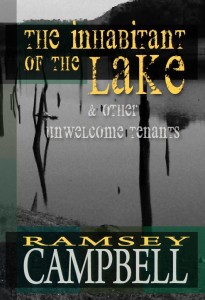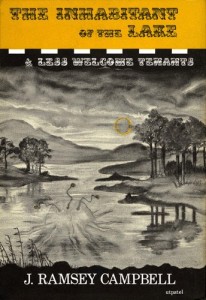
- All the stories contained in The Inhabitant of the Lake and Less Welcome Tenants; more on these below.
- Most if not all of the stories contained in the collection Cold Print.
- A half-dozen or so of the stories contained in the Demons by Daylight collection, despite Campbell’s protestations that this collection represents his efforts to move away from Lovecraft and establish his own style (including “Potential”; “The Franklyn Paragraphs”; “The Interloper, by Errol Undercliffe”; “The Sentinels”; “The Enchanted Fruit”; and “Made in Goatswood”).
- “The Horror under Warrendon,” Campbell’s own contribution to Made in Goatswood, a tribute anthology in which other authors celebrate Campbell’s Mythos stories (also collected in Dark Terrors 3).
- Three stories that are included in various other short story collections: “Dolls” (included in The 4th Mayflower Book of Black Magic Stories and Scared Stiff: Tales of Sex and Death); “The Pattern” (collected in Superhorror; The Far Reaches of Fear; Dark Companions; Dark Voices 3; and My Favorite Horror Story); and “The Other Names” (Interzone #137 and Dead But Dreaming).
- Two full-length novels: The Darkest Part of the Woods and The Last Revelation of Gla’aki.
Campbell sure has produced a lot of Mythos-related fiction, hasn’t he?
Let’s begin our discussion with Campbell’s first book-length publication and his first collection of Mythos stories, The Inhabitant of the Lake and Less Welcome Tenants (credited as J. Ramsey Campbell; Sauk City, Wisconsin: Arkham House, 1964), which included the following stories (reprint information included for each story):
- “The Room in the Castle”: reprinted in Cold Print (1st, 2nd, and expanded editions); Dark Feasts: The World of Ramsey Campbell (Robinson, 1987); Alone with the Horrors: The Great Short Fiction of Ramsey Campbell, 1961-1991 (Arkham House, 1993 and Headline, 1994; not included in 2004 Tor edition)
- “The Horror from the Bridge”: reprinted in Cold Print (1st, 2nd, and expanded editions)
- “The Insects from Shaggai”: reprinted in Cold Print (1st, 2nd, and expanded editions) and The Azathoth Cycle: Tales of the Blind Idiot God, ed. Robert M. Price (Chaosium, 1995)
- “The Render of the Veils”: reprinted in Cold Print (1st, 2nd, and expanded editions)
- “The Inhabitant of the Lake”: reprinted in Cold Print (1st, 2nd, and expanded editions)
- “The Plain of Sound”: reprinted in Cold Print (expanded edition only); Crypt of Cthulhu # 43 (Hallowmas 1986); The New Lovecraft Circle, ed. Robert M. Price (Fedogan and Bremer, 1996, Del Rey, 2004); and Song of Cthulhu: Tales of the Spheres Beyond Sound, ed. Stephen Mark Rainey (Chaosium, 2001).
- “The Return of the Witch”: reprinted in Cold Print (expanded edition only); and Crypt of Cthulhu # 43 (Hallowmas 1986).
- “The Mine on Yuggoth”: reprinted in Cold Print (expanded edition only); The Spawn of Cthulhu, ed. Lin Carter (Ballantine, 1971); and The Hastur Cycle, ed. Robert M. Price (Chaosium, 1993, 1997, 2006). An earlier version of this story was published as “The Tower of Yuggoth” in Crypt of Cthulhu # 43 (Hallowmas 1986).
- “The Will of Stanley Brooke”: reprinted in Cold Print (1st, 2nd, and expanded editions)
- “The Moon-Lens”: reprinted in Cold Print (1st, 2nd, and expanded editions) and The Shub-Niggurath Cycle: Tales of the Black Goat with a Thousand Young, ed. Robert M. Price (Chaosium, 1994)
The Inhabitant of the Lake and Less Welcome Tenants has never been reprinted by Arkham House, but it was reprinted by PS Publishing in 2011 as The Inhabitant of the Lake and Other Unwelcome Tenants, the original (and author’s preferred) title the collection was to have had. The PS Publishing edition includes an afterword by Campbell as well as the first drafts of the stories before Derleth’s revisions along with reproductions of Derleth’s written correspondence on these earliest drafts. While the original Arkham edition may be more highly prized by collectors, the newer edition is definitely more useful because of these additional materials; indeed, there’s no excuse not to acquire such an interesting and complete edition. Seven of the collection’s ten stories were reprinted in the first and second editions of Campbell’s later collection Cold Print, and the remaining three stories were included in the expanded edition of Cold Print. Several of these stories have been reprinted elsewhere as well, making the entirety of the original collection readily accessible.

lection, but a few points will have to suffice before diving into the individual stories comprising the collection in the next column.
First, this collection was published by August Derleth of Arkham House in 1964 in a hardcover edition of two thousand copies. The date of publication is relevant because Ramsey Campbell was born in 1946. When he wrote “A Word from the Author” on January 7, 1964, he had turned eighteen years of age just three days previously. Let that sink in a bit. These are wonderful stories that any horror author and fan of H. P. Lovecraft would be proud to have penned. That these stories were published when Campbell was just seventeen years old — and most were written when he was fifteen or sixteen — is nearly miraculous.
Second, this is the collection that established Campbell as a rising master of modern horror at such a young age. Fifty years later, Campbell remains a prolific writer of horror fiction, and though he never quite managed to become a household name in the same way as King and Koonz, his new output remains eagerly anticipated by fans on both sides of the Atlantic. He is certainly one of the foremost authors of Cthulhu Mythos stories still writing today. These are the stories that laid the groundwork for his reputation, and deservedly so.
Third, it is of critical importance that these stories are set in a fictionalized version of Britain’s Severn Valley, which became the first full realized setting for Cthulhu Mythos fiction outside of Lovecraft’s own New England (“Lovecraft Country,” as the late Keith Herber called it, encompassing the Miskatonic River area, to include Arkham, Kingsport, and Dunwich, as well as iconic locations slightly farther afield, including Innsmouth and Providence, among others). As he notes in the collection’s “A Word from the Author,” young Campbell had originally attempted to set his stories in New England, a place the teenage Briton had never visited. Editor August Derleth of Arkham House, gatekeeper and guardian of Lovecraft’s legacy for so long, strongly encouraged him to revise the stories to place them in a setting uniquely his own. Campbell did so, and has revisited the Severn Valley time and again in his Mythos stories. Not only did this new setting make the stories themselves take on a much greater sense of verisimilitude, but it also set the stage for other authors, either aping Lovecraft or attempting to make use of Lovecraft’s themes in their own way, to begin using other settings for tales of the Mythos. While Campbell turned away from Lovecraftian pastiches (for a time) after the publication of this collection — his next collection Demons by Daylight (Arkham House, 1973) would take him in very different directions — he would later return to his own unique vision of the Severn Valley and Campbell’s own corner of Lovecraft’s world.
The next installment of the column will begin exploring the individual stories of The Inhabitant of the Lake and Less Welcome Tenants, beginning with “The Room in the Castle.”
For such a prolific author, it is surprising that Campbell’s work has not attracted more popular or scholarly attention; there is remarkably little secondary discussion or criticism of Campbell’s, but then again that is true of virtually every living horror author, with the exception of Stephen King. For more information on Ramsey Campbell and his work, see:
Ramsey Campbell, Stefan R. Dziemianowicz, and S. T. Joshi The Core of Ramsey Campbell: A Bibliography and Reader’s Guide (West Warwick: Necronomicon Press, 1995).
Ramsey Campbell, Ramsey Campbell, Probably: On Horror and Sundry Fantasies (Harrogate: PS Publishing, 2002).
William Crawford, ed., Ramsey Campbell: Critical Essays on the Modern Master of Horror, as part of the Studies in Supernatural Literature, series editor S. T. Joshi (Lanham and Plymouth: Scarecrow Press, Inc., 2014).
S. T. Joshi, Ramsey Campbell and Modern Horror Fiction (Liverpool: Liverpool University Press, 2001).
[1] Note that the column title is taken from the author’s preferred title for his first collection of Mythos stories. I really like Campbell’s metaphor here because it seems to perfectly capture Lovecraft’s cosmicism and implications about the insignificance of mankind: while we may view ourselves as the owners and landlords of Earth, with various supernatural entities as our “unwelcome tenants,” from the perspective of these entities, we are of almost no significance whatsoever. Think of humanity as vermin or pests; ants can cause minor problems for humans, but when push comes to shove, the ants are going to lose every time. To continue the landlord/tenant analogy, a land developer certainly doesn’t consult with – or even notice – a colony of ants living on a parcel of land before building there. He simply bulldozes the colony and never thinks twice about it. After all, what are the ants going to do about it? The same might be said of humans in Lovecraft’s universe.
Questions, comments, and corrections are welcome; please contact the author, Andrew Byers at [email protected]








